How much does it cost to dig a well for water: a list of necessary works and prices for them
Special knowledge and experience when digging a well will make the water source efficient, high-quality and durable.Therefore, when constructing a well, it is better to contact specialists who will take into account the existing nuances.
When searching for a crew, a fair question arises: how much does it cost to dig a well for water and what does the cost consist of? When determining the price, several factors are taken into account, which together significantly influence the final price of the dig.
Next, we will talk about what factors influence the cost of installing a well on a personal plot.
The content of the article:
Construction of an aquifer well
A simple home water well has a standard layout. The lower level of the well structure is the water intake, then there is a trunk, which goes into the head - the above-ground part.
The water receiving part must be located deep in the water-saturated horizon in order for the well to be an inexhaustible source of water. In addition, it is installed at the bottom of the well bowl natural filter consisting of significant layers of sand, pebbles and stones, therefore the total depth of the trunk in which water is filled should be 1.5-2 rings below the aquifer.
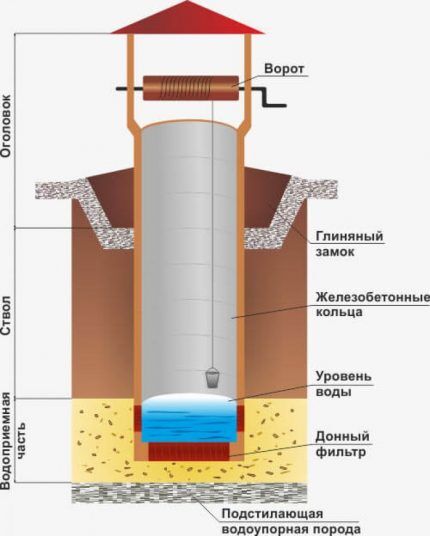
A well shaft consists of a shaft that is dug by hand or using a truck-mounted drilling rig equipped with a large-diameter auger.An automated excavation allows you to lift a large volume of earth in a short time, while the shaft of the mine will have the correct width throughout its entire depth, as well as even walls due to the fact that the drilling boom is positioned strictly horizontally.
In addition to digging a well shaft, a crane with a drilling rig makes it possible to place wall rings in the hole without much difficulty, especially since the first 2-3 rings must be primed, cemented and brackets installed on them before immersion.
After installing the underground rings, the head is installed. The head includes ground rings, as well as a mechanism for raising water. It can be a gate, manual or electric pump. When arranging a private house, you can install a winter water supply system, which is located underground, and install a summer surface tap.

The final work on the arrangement of the well is: arrangement of the roof, canopy or house, hoods and blind areas. A well made in accordance with all requirements will become a source of domestic and, possibly, drinking water.
Factors influencing cost
The cost of a water well when calling a team of craftsmen and when digging it yourself differs quite significantly. At the same time, digging alone, without the special equipment available to teams of workers, brings you closer to the result much longer than when calling professionals.
Materials for arranging a well shaft by region have approximately the same cost. Therefore, the independent purchase of reinforced concrete products and the purchase of well blocks from contractors are not too different in price.
In addition, delivery of oversized cargo is usually carried out for a fee. And when you purchase rings from a company that has ordered a well-digging service, the crane will deliver the wall fences along the way for a lower price.
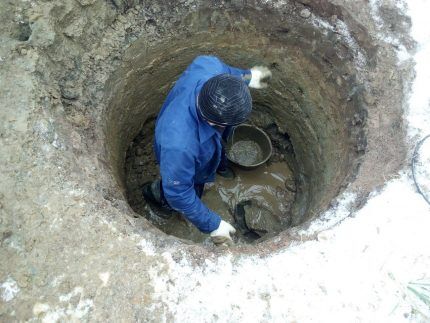
If a private owner decides to look for water on the site on his own, then he definitely needs the advice of an experienced geologist who knows exactly how to find the aquifer and the connection of underground veins. Thus, minimum costs for hired labor cannot be avoided.
Factor #1 - Finding Water
Before starting excavation work, it is necessary to determine the point in the area where the rich aquifer is located.
To obtain information about the hydrological condition of the site, you should call a geologist who is competent in this matter and will collect all the necessary information.
To find an aquifer it is necessary to determine:
- Relief of the site. To do this, you should inspect the area and determine where the elevations and lowlands are located and whether there are artificial or natural reservoirs on the site.
- Availability of wells among neighbors. If wells for water have already been built in the area, then you can be sure that somewhere on the site there is an abundant aquifer.
- Location of rivers. When digging a well on the river bank, closer than 50 m, you can get a polluted source of water, since underground streams will bring dirty water from the reservoir.
If, when finding out the information, there is no definitive answer as to where the water is located, the geologist begins a direct search for water using special means.

First, most accessible way to find water – use of wire frame. Searching for water using this method is based on the detection of underground flows.
The frame method gives good results if you have sufficient experience with the device, since the interpretation of the readings is intuitive. Calling a specialist and conducting searches using a frame cost on average from 2,500 to 3,000 rubles.
The next method is modern instrumental analysis of spectral seismic exploration – SSP. Computer diagnostics of soils determines tectonic faults and their water abundance throughout the entire area, after which the customer receives a complete picture of possible locations for drilling a well.
The cost of such a study starts from 15,000 rubles, standard prices in many regions are 22,000-29,000 rubles. The final result of the work is provided to the customer in 2-3 days. The probability of finding the source is 92%.
The BSC method has not yet become publicly available, so many regions use exploration drilling. Through hydrogeological analysis of the area and the passage of a frame or vine, several points are found at which it is possible to construct a well.
After which, in the most suitable place, according to the specialist, a small-diameter well is drilled in order to make sure that there really is an underground flow and determine the depth of the aquifer.
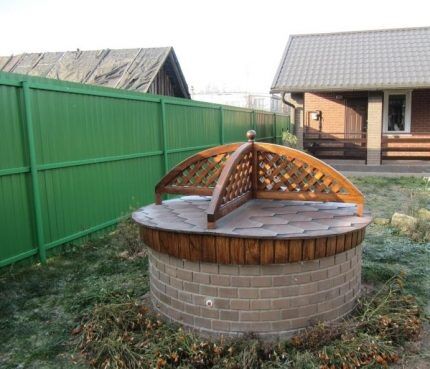
For a long time, a geologist's hand drill was used for test drilling. This method accurately shows the depth of the aquifer, but the drilling depth does not exceed 10 meters. The average price for searching for water using a hand drill is 5,000 rubles.
In some northern regions with rocky soil, the cost of manual drilling a well is 2500-2600 rubles. per meter
Modern well diggers use an efficient automatic motor drill. In this case, the depth indicator has a small error, but the drilling speed is many times higher and specialists do not need to make any effort to dig.
The cost of automatic well digging starts from 8,000 and reaches 12,000 rubles. Some contractor companies indicate in their price list that the first 12 meters of digging cost 8,000 rubles, and if the aquifer is not found, then each subsequent meter of digging costs 1,000 rubles.
Factor No. 2 - earthworks
The main work when installing a source of water intake is digging a well shaft, so the cost of performing this work depends on the depth of drilling. The footage of the well trunk is measured in the number of wall rings, since one Precast concrete products for a water well has a height of 0.9-1 meter.
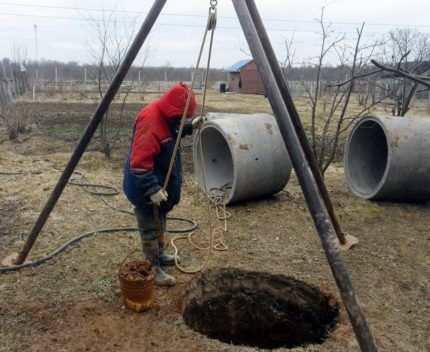
The standard price for digging a well shaft one wall ring deep is the cost of the reinforced concrete product itself. The price for commonly used wall rings KS-10-9 varies from 1600 to 2500 rubles.
Based on this, the cost of digging soil in standard soils to a depth of 8-10 rings is 1600-2500 rubles per meter. In the central regions of the country, the average price for digging 1-10 rings of a well is 4,000 rubles. After 8-10 rings, the price of each next meter increases by 500-1000 rubles.
It is worth considering that the digging is carried out to the aquifer and then goes 1-2 rings deeper into it, so that the structure maintains a constant supply of water. If the water-bearing layer of the tunnel is located in quicksand or hard soil, then it should be deepened by at least 2 reinforced concrete rings. Work to overcome quicksand or hard ground costs twice as much as standard digging.
Factor No. 3 - installation cost
In addition to earthworks, when constructing a well, the installation of reinforced concrete rings in the well shaft, their fastening together using primer, concrete and liquid glass or hydraulic seals, as well as their clamping are paid.

The brackets keep the rings from moving vertically, so in sandy soils and in areas with deep frozen soils, such locks are necessary. Rebated locks located at the ends of the rings help prevent horizontal displacement of the rings.
Taping and waterproofing each seam costs an average of 1,500 rubles, depending on the materials used to seal the seam.
The construction of a well includes the installation of the well head, which consists of a floor slab and an inspection hatch. If additional rings and heads are required, then their installation is paid separately from 500 rubles for each element.
For reliable operation and good water quality, a filter is installed in the well. The natural bottom filter consists of 25 cm of quartz sand, 25 cm of small river pebbles and 25 cm of large stones.
The cost of installing a filter depends on the cost of materials, which on average will cost 1,500 rubles, and if a surface metal mesh is used, then it will cost more for the cost of the mesh and its installation in the well shaft.
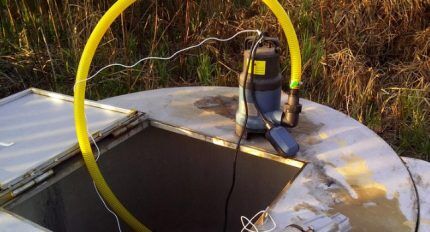
In addition to the shaft and filter, the main work includes the installation of a lifting mechanism. When installing a valve with a carabiner and cable, installation will cost 500-700 rubles. When installing mechanical (manual) or electric submersible pump the cost of work starts from 1000 rubles.
Factor No. 4 - price of structural elements
The well design is a shaft made of reinforced concrete products, which ends with a head in the form of a concrete slab and a metal or polypropylene hatch.
The cost of reinforced concrete wall rings depends on the diameter and height of the products. Rings with a diameter of 10 dm and a height of 5 dm are considered convenient, but not very practical. Such monoliths cost around 1000 rubles. and are used when constructing a well by one or two people, in the process of building a device with their own hands.
When digging a well by a team of hired workers and they have a manipulator, the optimal ring sizes are KS 10-10 and KS 10-9, where the first number indicates the internal diameter, and the second the height of the product.
The cost of such rings varies from 1600 to 2500 rubles. The minimum depth of the well is 4 reinforced concrete rings, the maximum reaches 40 rings. A floor slab is installed on the head of the well shaft, which costs an average of 2,500 rubles. and a hatch, costing 1,500 rubles.
If to achieve the optimal height it is necessary to install an additional and support ring, then the cost of materials increases by the price of additional materials.
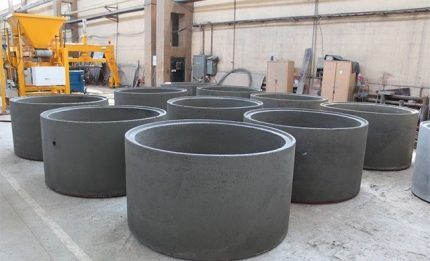
For efficient operation of the well and rapid rise of water, it is necessary to install a well pump in the shaft or on the surface. The most affordable pump models - vibration. Their cost varies from 1000 to 4000 rubles, depending on power, lifting height, productivity and other parameters.
Disadvantages of vibration pumps Zubr, Brook, Baby, PATRIOT, is that they create vibration, which leads to silting of the pores.The rubber gaskets on the device gradually become unusable due to the ingress of small sand particles.
In addition, vibration devices are unsuitable for working on quicksand, and many cheap models are effective when pumping water only up to the 5th-6th ring.
But if the water coming from the aquifer is clean or a bottom filter is installed, which is replaced and cleaned once a year, then an economical vibration device can be purchased and installed.
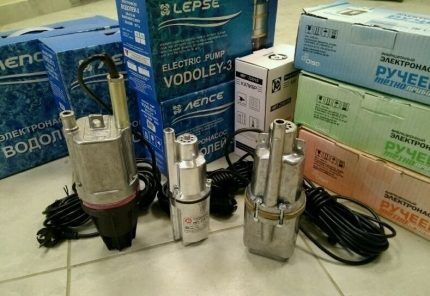
If the capacity of vibration pumps is insufficient and to obtain good performance, you should purchase submersible or superficial centrifugal pumps. Surface pumps are effective at depths of up to 8 meters, and some submersible pumps have lift heights of up to 75 meters.
The cost of well pumps with a centrifugal design starts from 12,000 rubles. The most powerful devices have a price of 30,000-32,000 rubles.
The cost of constructing a well
How much it will cost to install a well depends on the owner’s preferences. If the standard work of digging a shaft, installing a shaft and a pump is sufficient, then you can complete the construction and use the well in its original form.
The arrangement of a well includes the construction of a well canopy or house, the filling of a clay castle and formwork, as well as the installation of an autonomous water supply.
The cost of building well houses and sheds by a team of workers starts from 7,000 rubles. In addition to construction costs, the owner needs to purchase materials: boards, hinges, nails and roofing.
Construction companies offer ready-made well structures of various sizes and styles. The price of such a house is influenced by the material of manufacture, the complexity of the design, and the presence of decorative elements. Thus, the simplest house made of clapboard and corrugated board costs from 7,000 rubles, houses made of timber, a block house with tiles are estimated at 35,000-60,000 rubles, and elite sheds with hand-carved elements cost an average of 90,000 rubles.
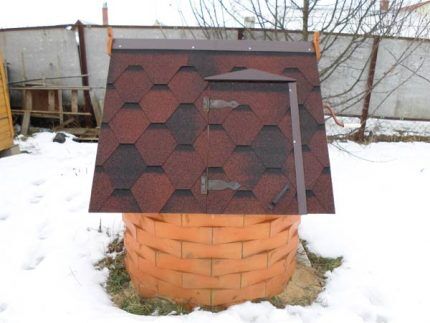
According to the document: “Hygienic requirements for the quality of water from non-centralized water supply. Sanitary protection of sources”, in areas with sandy and sandy loam soils, the well must be equipped with a clay lock. Clay castle is a layer of clay compacted around the well that protects well water from the ingress of untreated moisture.
The cost of installing a lock is 5,000 rubles. If, when digging a well, no deposits of pure clay were found, then it must be purchased. One bag of clay costs 25-50 rubles, it should be enough to fill a ravine around a well 1 meter wide and 2 meters deep.
When installing autonomous water supply it is necessary to perform the following types of work: drilling a hole on a reinforced concrete product to secure a pipe, installing pipes and digging a shaft 1-1.2 meters deep from the well to the house.
All work and materials are paid additionally.The price of installing metal pipes for street water supply is 380-520 rubles. per meter, the price of installation and digging a trench of 1 meter of winter water supply is 950-1500 rubles.

In addition to the listed costs, contractor firms can set additional tariffs for: loading, unloading and delivery of reinforced concrete products, delivery of workers, if the facility is located at a considerable distance from the company’s office. Some construction companies set a fee for rolling rings further than 20 m, so it is necessary to prepare a place for unloading directly next to the well.
Another type of cost is associated with the removal of soil and deep rocks from the site, as well as with the transfer of soil further than 5 meters. The work of the crane-manipulator is paid separately; it can be set at a piece rate or hourly.
The cost of a turnkey well at average prices for a depth of 10 rings, with the installation of a well house, starts from 52,800 rubles, 15 rings - from 75,600 rubles, 20 rings - 98,100 rubles.
Conclusions and useful video on the topic
What does digging a turnkey well include and how to reduce the cost of a well using materials:
What to consider when digging a well, professional advice:
Digging a well for water on a personal plot is labor-intensive and expensive. But you should not save on such an important resource as water, since one-time costs for high-quality arrangement of an autonomous water supply will quickly pay for themselves and make the further stay of the owners of a country house comfortable.
If you have ever encountered arrangement of a well on your own site, please tell us how much the arrangement cost. Leave your comments in the block below. There you can ask questions about the topic of the article.




We hired a team of migrant workers to our dacha in the suburbs to dig a well. It’s better, of course, to take trusted ones who have already dug for someone they know. All work was carried out on a turnkey basis. He immediately announced how many rings were needed, and the final cost, of course, depends on this. Although in fact, if you have time and desire, you can do everything yourself. Especially if you know where the water is, but I had neither one nor the other. I ended up with about 50 thousand for everything.
If you have a choice between a well and a borehole, then definitely choose a well. At one time I thought and chose for a long time, it’s good that experienced people suggested it. A well, unlike a well, is not constantly silted or covered with sand. When the pump operates, sand rises significantly less and is easier to clean. If for some reason the electricity is turned off, you will not be left without water with a well. And it costs a lot less.